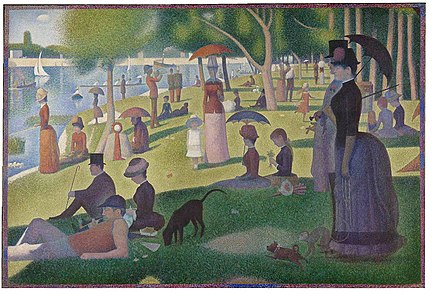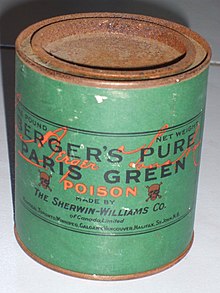
Paris green

| |
| Names | |
|---|---|
| Other names
C.I. pigment green 21, emerald green, Schweinfurt green, imperial green, Vienna green, Mitis green, Veronese green
| |
| Identifiers | |
|
3D model (JSmol)
|
|
| ChemSpider | |
| ECHA InfoCard | 100.125.242 |
| EC Number |
|
|
PubChem CID
|
|
| UNII | |
| UN number | 1585 |
|
CompTox Dashboard (EPA)
|
|
| |
| |
| Properties | |
| Cu(C2H3O2)2·3Cu(AsO2)2 | |
| Molar mass | 1013.79444 g/mol |
| Appearance | Emerald green crystalline powder |
| Density | >1.1 g/cm3 (20 °C) |
| Melting point | > 345 °C (653 °F; 618 K) |
| Boiling point | decomposes |
| insoluble | |
| Solubility | soluble but unstable in acids insoluble in alcohol |
| Hazards | |
| GHS labelling: | |
 
|
|
| Danger | |
| H302, H410 | |
| P260, P264, P273, P280, P301+P312, P301+P330+P331, P303+P361+P353, P304+P340, P305+P351+P338, P310, P362, P391, P405, P501 | |
| Lethal dose or concentration (LD, LC): | |
|
LD50 (median dose)
|
22 mg/kg |
| NIOSH (US health exposure limits): | |
|
PEL (Permissible)
|
[1910.1018] TWA 0.010 mg/m3 |
|
REL (Recommended)
|
Ca C 0.002 mg/m3 [15-minute] |
|
IDLH (Immediate danger)
|
Ca [5 mg/m3 (as As)] |
| Safety data sheet (SDS) | CAMEO MSDS |
|
Except where otherwise noted, data are given for materials in their standard state (at 25 °C [77 °F], 100 kPa).
| |
| Paris green | |
|---|---|
|
| |
| Hex triplet | #50C878 |
| sRGBB (r, g, b) | (80, 200, 120) |
| HSV (h, s, v) | (140°, 60%, 78%) |
| CIELChuv (L, C, h) | (72, 71, 137°) |
| Source | Maerz and Paul |
| ISCC–NBS descriptor | Vivid yellowish green |
|
B: Normalized to [0–255] (byte) | |
Paris green (copper(II) acetate triarsenite or copper(II) acetoarsenite) is an arsenic-based organic pigment. As a green pigment it is also known as Schweinfurt green, emerald or Vienna green. It is a highly toxic emerald-green crystalline powder that has been used as a rodenticide and insecticide, and also as a pigment. It was manufactured in 1814 to be a pigment to make a vibrant green paint, and was used by many notable painters in the 19th century. The color of Paris green is said to range from a pale blue green when very finely ground, to a deeper green when coarsely ground. Due to the presence of arsenic, the pigment is extremely toxic and in paintings, the color can degrade quickly.
Preparation and structure
Paris green may be prepared by combining copper(II) acetate and arsenic trioxide. The structure was confirmed by X-ray crystallography.
History
In 1814, Paris green was invented by paint manufacturers, Wilhelm Sattler and Friedrich Russ, in Schweinfurt, Germany for the Wilhelm Dye and White Lead Company. They were attempting to produce a more stable pigment than Scheele's green, seeking to make a green that was less susceptible to darkening around sulfides. In 1822, the recipe for emerald green was published by Justus von Liebig and André Braconnot. In 1867, the pigment was named Paris green and was officially recognized as the first chemical insecticide in the world. Because of its arsenic content, the pigment was dangerous and toxic to manufacture, often resulting in factory poisonings. At the time, emerald green was praised as a more durable and vibrant substitute for Scheele’s green, even though it would later prove to degrade quickly and react with other manufactured paints.
Pigment
In paintings, the pigment produces a rich, dark green with an undertone of blue. In comparison, Scheele's green is more yellow, and therefore, more lime-green. Paris green became popular in the 19th because of its brilliant color. It was also called Emerald green because of its resemblance to the gemstone's deep color.
Notable occurrences
Paris green was widely used by 19th-century artists. It is present in several paintings by Claude Monet and Paul Gauguin, who found its color difficult to replicate with natural materials.
Permanence
The pigment has a tendency to darken and turn brown. The issue was already apparent in the 19th century. In a 1888 study, watercolors with the pigment were shown to darken and turn brown when exposed to natural light and air. Experiments at the turn of the 20th century gave mixed results. Some found that the Paris green degraded slightly while other sources said the pigment was weatherproof. This discrepancy could be due to the fact that each experiment used a different brand of Paris green.
Paris green in Descente des Vaches by Théodore Rousseau has changed significantly.
Related pigments
Similar natural compounds are the minerals chalcophyllite Cu
18Al
2(AsO
4)
3(SO
4)
3(OH)
27·36H
2O, conichalcite CaCu(AsO
4)(OH), cornubite Cu
5(AsO
4)
2(OH)
4·H
2O, cornwallite Cu
5(AsO
4)
2(OH)
4·H
2O, and liroconite Cu
2Al(AsO
4)(OH)
4·4H
2O. These minerals range in color from greenish blue to slightly yellowish green.
Scheele's green is a chemically simpler, less brilliant, and less permanent, copper-arsenic pigment used for a rather short time before Paris green was first prepared, which was approximately 1814. It was popular as a wallpaper pigment and would degrade, with moisture and molds, to arsine gas. Paris green was also used in wallpaper to some extent and may have also degraded similarly. Both pigments were once used in printing ink formulations.
The ancient Romans used one of them, possibly conichalcite, as a green pigment. The Paris green paint used by the Impressionists is said to have been composed of relatively coarse particles. Later, the chemical was produced with increasingly small grinds and without carefully removing impurities; its permanence suffered. It is likely that it was ground more finely for use in watercolors and inks, too.
Insecticide
In 1867, farmers in Illinois and Indiana found that Paris green was effective against the Colorado potato beetle, an aggressive agricultural pest. Despite concerns regarding the safety of using arsenic compounds on food crops, Paris green became the preferred method for controlling the beetle. By the 1880s, Paris green had become the first widespread use of a chemical insecticide in the world. It was also used widely in the Americas to control the tobacco budworm, Heliothis virescens.
Paris green was heavily sprayed by airplane in Italy, Sardinia, and Corsica during 1944 and in Italy in 1945 to control malaria. It was once used to kill rats in Parisian sewers, which is how it acquired its common name.
However, the manufacturing of the insecticide caused many health complications for factory workers, and in certain cases was lethal.
Mixing "Paris green" and road dust preparatory to dusting streams and breeding places of mosquitoes during World War II
See also
Further reading
- Fiedler, I. and Bayard, M. A., "Emerald Green and Scheele’s Green", in Artists' Pigments: A Handbook of Their History and Characteristics, Vol. 3: E.W. Fitzhugh (Ed.) Oxford University Press 1997, pp. 219–271
- Hughes, Michael F.; et al. (2011). "Arsenic Exposure and Toxicology: A Historical Perspective". Toxicological Sciences. 123 (2): 305–332. doi:10.1093/toxsci/kfr184. PMC 3179678. PMID 21750349.
- Sorensen, W. Conner (1995). Brethren of the Net, American Entomology, 1840-1880. University of Alabama Press. pp. 124–125.
- Spear, Robert J., The Great Gypsy Moth War, A History of the First Campaign in Massachusetts to Eradicate the Gypsy Moth, 1890–1901. University of Massachusetts Press, Amherst and Boston, 2005. ISBN 1-55849-479-0
External links
- Case Studies in Environmental Medicine - Arsenic Toxicity
- How Emerald green is made
- National Pollutant Inventory - Copper and compounds fact sheet
- Emerald green, Colourlex
|
Acetyl halides and salts of the acetate ion
| ||||||||||||||||||||||||||||||||||||||||||||||||||||||||||||||||||||||||||||||||||||||||||||||||||||||||||||||||||||||||||||||||||||||||||||||||||||||||||||||||||||
|---|---|---|---|---|---|---|---|---|---|---|---|---|---|---|---|---|---|---|---|---|---|---|---|---|---|---|---|---|---|---|---|---|---|---|---|---|---|---|---|---|---|---|---|---|---|---|---|---|---|---|---|---|---|---|---|---|---|---|---|---|---|---|---|---|---|---|---|---|---|---|---|---|---|---|---|---|---|---|---|---|---|---|---|---|---|---|---|---|---|---|---|---|---|---|---|---|---|---|---|---|---|---|---|---|---|---|---|---|---|---|---|---|---|---|---|---|---|---|---|---|---|---|---|---|---|---|---|---|---|---|---|---|---|---|---|---|---|---|---|---|---|---|---|---|---|---|---|---|---|---|---|---|---|---|---|---|---|---|---|---|---|---|---|---|
| ||||||||||||||||||||||||||||||||||||||||||||||||||||||||||||||||||||||||||||||||||||||||||||||||||||||||||||||||||||||||||||||||||||||||||||||||||||||||||||||||||||
A typical sample is shown for each name; a range of color-variations is commonly associated with each color-name. |




